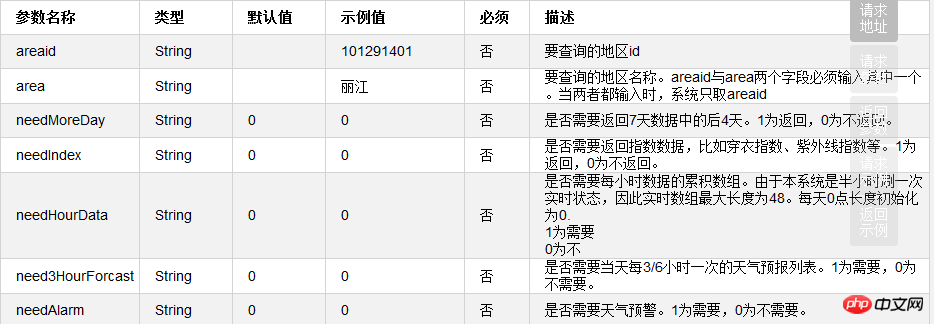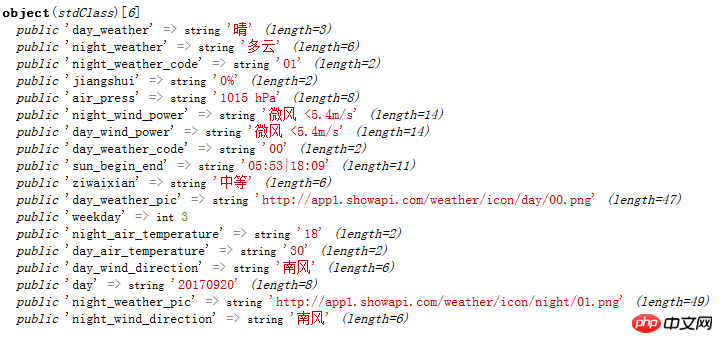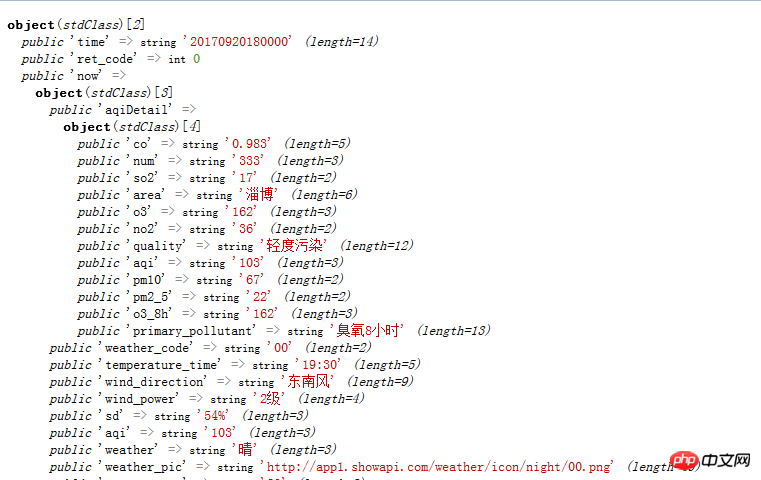 Backend Development
Backend Development
 PHP Tutorial
PHP Tutorial
 Introduction to the method of calling the API interface to query the weather function in PHP
Introduction to the method of calling the API interface to query the weather function in PHP
Introduction to the method of calling the API interface to query the weather function in PHP
The following editor will bring you an example of using PHP to call the API interface to implement the weather query function. The editor thinks it’s pretty good, so I’ll share it with you now and give it as a reference. Let’s follow the editor to take a look.
Weather forecast query interface API. Here I use the National Meteorological Administration weather forecast interface
The most commonly used ones are: Sina Weather Forecast interface, Baidu weather forecast interface, Google weather interface, Yahoo weather interface, etc.
1. Query method
Query the weather conditions of each city based on place names
2.Request URL address
http://route.showapi.com/9-2
3. Interface parameter description:
1. System-level parameters (parameters required by all access points):

2. Application-level parameters (each access point has its own parameters):

4. Return parameters
Return results in JSON format
1) System-level parameters (all access Parameters that will be returned when clicking)
2) Application-level parameters (json data structure in the system-level output parameter showapi_res_body field)
Specific calling operation:
PHP comes with built-in functions for processing json format strings. Let’s do an example below and give the complete code:
<?php
//查找淄博天气情况
//接口自带编写的数组
$showapi_appid = '46435'; //替换此值,在官网的"我的应用"中找到相关值
$showapi_secret = '7c55aef4ede442ffa49b24c2c808e523'; //替换此值,在官网的"我的应用"中找到相关值
$paramArr = array(
'showapi_appid'=> $showapi_appid,
'areaid'=> "",
'area'=> "淄博",
'needMoreDay'=> "",
'needIndex'=> "",
'needHourData'=> "",
'need3HourForcast'=> "",
'needAlarm'=> ""
//添加其他参数
);
//创建参数(包括签名的处理)接口自带编写的数组
function createParam ($paramArr,$showapi_secret) {
$paraStr = "";
$signStr = "";
ksort($paramArr);
foreach ($paramArr as $key => $val) {
if ($key != '' && $val != '') {
$signStr .= $key.$val;
$paraStr .= $key.'='.urlencode($val).'&';
}
}
$signStr .= $showapi_secret;//排好序的参数加上secret,进行md5
$sign = strtolower(md5($signStr));
$paraStr .= 'showapi_sign='.$sign;//将md5后的值作为参数,便于服务器的效验
return $paraStr;
}
$param = createParam($paramArr,$showapi_secret);
$url = 'http://route.showapi.com/9-2?'.$param;
//获取json格式的数据
$result = file_get_contents($url);
//对json格式的字符串进行编码
$arr = (json_decode($result));
$v = $arr->showapi_res_body;$attr = $v->f1;
//所需要的数据进行调用
$arr1 = $attr->day_weather;
$arr2 = $attr->night_weather;
$arr3 = $attr->night_air_temperature;
$arr4 = $attr->day_air_temperature;
$arr5 = $attr->day_wind_direction;
$arr6 = $attr->night_weather_pic;
echo $arr6;
?>
//将所需要的数据添加到数据库
<?php
require_once "./DBDA.class.php";
$db = new DBDA();
$sql = "insert into weather values('','{$arr1}','{$arr2}')";
$arr = $db->query($sql);
?>Effect As shown in the picture:


The above is the detailed content of Introduction to the method of calling the API interface to query the weather function in PHP. For more information, please follow other related articles on the PHP Chinese website!

Hot AI Tools

Undresser.AI Undress
AI-powered app for creating realistic nude photos

AI Clothes Remover
Online AI tool for removing clothes from photos.

Undress AI Tool
Undress images for free

Clothoff.io
AI clothes remover

AI Hentai Generator
Generate AI Hentai for free.

Hot Article

Hot Tools

Notepad++7.3.1
Easy-to-use and free code editor

SublimeText3 Chinese version
Chinese version, very easy to use

Zend Studio 13.0.1
Powerful PHP integrated development environment

Dreamweaver CS6
Visual web development tools

SublimeText3 Mac version
God-level code editing software (SublimeText3)

Hot Topics
 1384
1384
 52
52
 PHP 8.4 Installation and Upgrade guide for Ubuntu and Debian
Dec 24, 2024 pm 04:42 PM
PHP 8.4 Installation and Upgrade guide for Ubuntu and Debian
Dec 24, 2024 pm 04:42 PM
PHP 8.4 brings several new features, security improvements, and performance improvements with healthy amounts of feature deprecations and removals. This guide explains how to install PHP 8.4 or upgrade to PHP 8.4 on Ubuntu, Debian, or their derivati
 How To Set Up Visual Studio Code (VS Code) for PHP Development
Dec 20, 2024 am 11:31 AM
How To Set Up Visual Studio Code (VS Code) for PHP Development
Dec 20, 2024 am 11:31 AM
Visual Studio Code, also known as VS Code, is a free source code editor — or integrated development environment (IDE) — available for all major operating systems. With a large collection of extensions for many programming languages, VS Code can be c
 7 PHP Functions I Regret I Didn't Know Before
Nov 13, 2024 am 09:42 AM
7 PHP Functions I Regret I Didn't Know Before
Nov 13, 2024 am 09:42 AM
If you are an experienced PHP developer, you might have the feeling that you’ve been there and done that already.You have developed a significant number of applications, debugged millions of lines of code, and tweaked a bunch of scripts to achieve op
 How do you parse and process HTML/XML in PHP?
Feb 07, 2025 am 11:57 AM
How do you parse and process HTML/XML in PHP?
Feb 07, 2025 am 11:57 AM
This tutorial demonstrates how to efficiently process XML documents using PHP. XML (eXtensible Markup Language) is a versatile text-based markup language designed for both human readability and machine parsing. It's commonly used for data storage an
 Explain JSON Web Tokens (JWT) and their use case in PHP APIs.
Apr 05, 2025 am 12:04 AM
Explain JSON Web Tokens (JWT) and their use case in PHP APIs.
Apr 05, 2025 am 12:04 AM
JWT is an open standard based on JSON, used to securely transmit information between parties, mainly for identity authentication and information exchange. 1. JWT consists of three parts: Header, Payload and Signature. 2. The working principle of JWT includes three steps: generating JWT, verifying JWT and parsing Payload. 3. When using JWT for authentication in PHP, JWT can be generated and verified, and user role and permission information can be included in advanced usage. 4. Common errors include signature verification failure, token expiration, and payload oversized. Debugging skills include using debugging tools and logging. 5. Performance optimization and best practices include using appropriate signature algorithms, setting validity periods reasonably,
 PHP Program to Count Vowels in a String
Feb 07, 2025 pm 12:12 PM
PHP Program to Count Vowels in a String
Feb 07, 2025 pm 12:12 PM
A string is a sequence of characters, including letters, numbers, and symbols. This tutorial will learn how to calculate the number of vowels in a given string in PHP using different methods. The vowels in English are a, e, i, o, u, and they can be uppercase or lowercase. What is a vowel? Vowels are alphabetic characters that represent a specific pronunciation. There are five vowels in English, including uppercase and lowercase: a, e, i, o, u Example 1 Input: String = "Tutorialspoint" Output: 6 explain The vowels in the string "Tutorialspoint" are u, o, i, a, o, i. There are 6 yuan in total
 Explain late static binding in PHP (static::).
Apr 03, 2025 am 12:04 AM
Explain late static binding in PHP (static::).
Apr 03, 2025 am 12:04 AM
Static binding (static::) implements late static binding (LSB) in PHP, allowing calling classes to be referenced in static contexts rather than defining classes. 1) The parsing process is performed at runtime, 2) Look up the call class in the inheritance relationship, 3) It may bring performance overhead.
 What are PHP magic methods (__construct, __destruct, __call, __get, __set, etc.) and provide use cases?
Apr 03, 2025 am 12:03 AM
What are PHP magic methods (__construct, __destruct, __call, __get, __set, etc.) and provide use cases?
Apr 03, 2025 am 12:03 AM
What are the magic methods of PHP? PHP's magic methods include: 1.\_\_construct, used to initialize objects; 2.\_\_destruct, used to clean up resources; 3.\_\_call, handle non-existent method calls; 4.\_\_get, implement dynamic attribute access; 5.\_\_set, implement dynamic attribute settings. These methods are automatically called in certain situations, improving code flexibility and efficiency.



